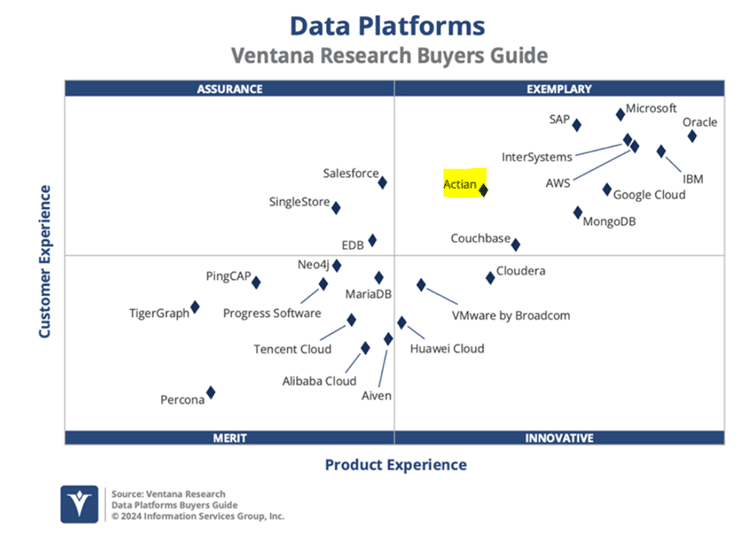Understanding the Value of a True Data Platform
Phil Ostroff
July 31, 2024

There are many existing and emerging database solutions throughout the market today. Some offer specific functional capabilities, such as data integration, data warehousing and data analytics, whereas others offer a combination of these services, plus additional capabilities, under what is generally called a “platform.” But what really makes a true data “platform” these days? And how does the answer to this question help you, as someone approaching the market looking for a data platform, decide what’s best from a cost and functionality perspective?
What Makes a True Data Platform?
This is such an interesting question. The data journey itself consists of several stages, with handoff points that data moves through to ultimately get to a usable state. There are many use cases and requirements when it comes to what you can do with data and why and where you can deploy it. You also need to take into account the different industries that are affected by various local or regional requirements. Additionally, there are different user types or personas who have different data needs.
Still, the data journey remains mostly the same across organizations, and many vendors in the market today claim to provide data “platforms” that support this journey. In reality, they are really only providing data warehousing with other capabilities “bolted on” via partnerships or hastily executed acquisitions. This leaves the data journey fragmented with the potential for increasing costs, reduced data quality and increased risk.
A true data platform goes beyond only storing information. Within a single offering, it acts as a central hub, seamlessly ingesting data from various sources, organizing it efficiently, and making it readily available for analysis. This empowers users across the organization, from data scientists to business analysts, to unlock valuable insights that drive better decision-making. This is regardless of industry, geographic interest of the business, or stakeholder involved.
What Are the Advantages of a True Data Platform?
A true platform, one that covers data integrations, warehousing and analytics, brings forth the following key advantages:
Streamlined Workflow
A single platform creates a smooth flow of data from its various sources (via integration) to the data warehouse for storage and then directly to the analytics tools for insights. This eliminates the need to export and import data between separate systems, saving time and effort, while avoiding the need for a variety of tools.
Improved Data Consistency
With everything on one platform, data maintains consistency throughout the process. This reduces errors caused by data transformations or discrepancies between different systems.
Faster Time to Insights
By eliminating the need to move data between multiple platforms, you can get to valuable insights much faster. This allows for quicker decision-making based on real-time data.
Simplified Management
Managing a single platform is significantly easier than managing a collection of separate tools. This reduces the IT burden and frees up resources for other tasks.
Enhanced Data Quality
A unified platform often has built-in features for data cleansing and transformation, ensuring the quality of data used for analysis.
Reduced Costs
While a single platform may have a higher upfront cost than individual solutions, it can be more cost-effective in the long run. You’ll save on licensing fees for multiple products and potentially reduce IT maintenance costs.
What Risks Do You Run if You Choose Something Else?
If you look closely at some database solution offerings, you will discover that they are not true platforms. Rather, they are components of an ecosystem: a key offering (typically data warehouse) merged with third-party data integrations and analytics tools.,
These are not true platforms due to the interdependency of each system’s connectivity with other systems. This can present a series of issues:
Data Silos and Inconsistencies
Separate systems can create data silos, where information gets trapped and isn’t readily available for analysis. This can lead to inconsistencies and discrepancies in the data across different tools.
Complex Workflows
Moving data between separate systems can be a complex and time-consuming process, involving manual steps and data transformations. This can slow down the process of getting insights from your data.
Increased Costs
The cost of licensing and maintaining multiple tools can add up quickly. Additionally, the need for additional IT resources to manage these separate systems can further increase costs.
Delayed Insights
The complexity of data movement between systems can lead to delays in getting insights from your data. This can hinder your ability to make timely decisions based on real-time information.
Reduced Data Quality
The process of moving data between systems can introduce errors and inconsistencies. Without built-in data quality checks, it’s harder to ensure the accuracy of your data for analysis.
Management Challenges
Managing and maintaining multiple data tools requires significant IT expertise. This can be a burden for smaller organizations or those with limited IT resources.
Security Concerns
Each data handoff point from one solution to another presents a weakness that could be exploited by hackers. Reducing security threats is extremely important, especially given the frequency and sophistication of recent security breaches.
Potential Customer Service Issues
Dealing with multiple vendor solutions across the data journey may lead to disparate or disconnected customer experiences. This, in turn, leads to additional time to fix issues and causes frustration.
Additionally, specific businesses may decide to make their own “platforms” by piecing together various solutions that they feel best address their own data journey requirements. In speaking with several of these businesses, we’ve learned they have run into most, if not all, of the issues listed above.
What they believe are time- and money-saving approaches to creating a system that supports their data journey becomes an expensive, heavily decentralized and ungovernable nightmare. Data gets siloed quickly and different teams handle different aspects of the data journey, which can cause a breakdown in communications and procedures, and things slowly spiral out of control.
Consider the Actian Data Platform for All Data Requirements
The Actian Data Platform provides end-to-end integration, data warehouse and analytics capabilities across your entire environment at unmatched price-performance. The platform allows you to collect, manage and analyze data with one solution, eliminating the disadvantages noted above.
Key benefits of the Actian Data Platform include:
Data Quality Monitoring
Turn your data into a trusted, strategic asset with built-in data quality rules and transformations. Enjoy features like automatic rule generation, reusable rules and rule sets, and intuitive dashboards.
High Concurrency
With Actian’s high concurrency capabilities, you can support a multitude of simultaneous queries, transactions and analytical tasks without sacrificing performance.
Vector Processing and CPU Cache Maximization
With Vector processing and CPU cache maximization at its core, the data platform delivers scalability, high-performance and data processing speed for real-time analytic workloads.
Advanced Columnar Storage
By embracing advanced columnar storage, the Actian Data Platform empowers users to derive insights from their data at unparalleled speeds, making it a robust choice for data analytics, reporting and business intelligence applications.
REAL Real-Time Analytics
The patented technology of the Actian Data Platform allows you to keep your analytics dataset up-to-date without affecting downstream query performance – ideal for speedy analytic outcomes.
Separation of Compute and Storage
Unlike traditional monolithic systems in which computing and storage are tightly coupled, Actian’s architecture decouples these components, allowing you to independently scale compute and storage resources based on specific needs.
Don’t just take our word for it! Our platform was ranked “Exemplary” in the recent Ventana Data Platforms Buyer’s Guide (2024). This guide is based on actual product testing, looking at both the product and customer experience for each solution featured in the study.
Our platform performed exceptionally well in the “Manageability” category, a key functional area that makes a true platform stand out. Ventana’s team stated that “The growing importance of simplifying Manageability is critical and should be a priority for all software provider evaluations.” Actian also scored highly in customer service categories, an area in which other well-known vendors failed to score at all.

The Actian Data Platform provides all of the capabilities you need to confidently take on the data journey required for your business, regardless of your industry, geography and end-user requirements.
So, if you’re looking at various offerings that are either ecosystem-type solutions packaged together as a “platform” or if you’re thinking of putting together several separate vendor solutions to meet your needs, think about how the Actian Data Platform can save you time, money and effort while giving you complete confidence in your data.
Consider a demo of the platform. You won’t be disappointed!
Subscribe to the Actian Blog
Subscribe to Actian’s blog to get data insights delivered right to you.
- Stay in the know – Get the latest in data analytics pushed directly to your inbox.
- Never miss a post – You’ll receive automatic email updates to let you know when new posts are live.
- It’s all up to you – Change your delivery preferences to suit your needs.
